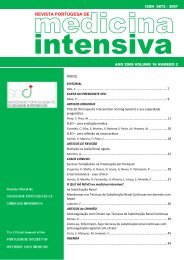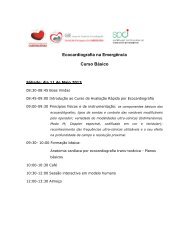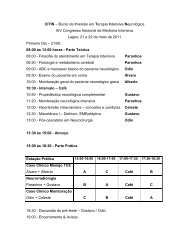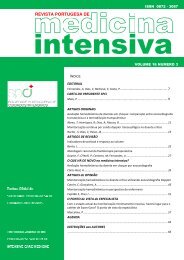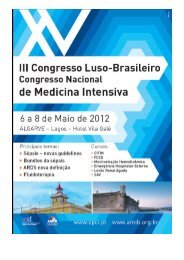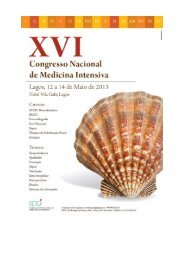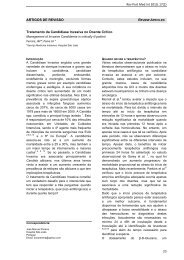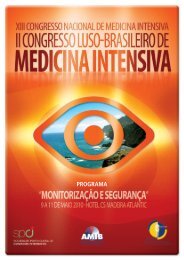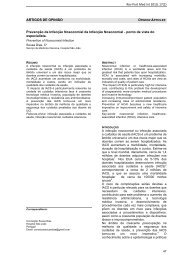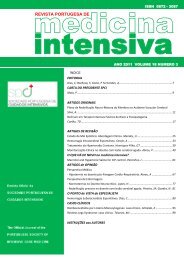Março de 2011 - Vol 18 numero 1 - Sociedade Portuguesa de ...
Março de 2011 - Vol 18 numero 1 - Sociedade Portuguesa de ...
Março de 2011 - Vol 18 numero 1 - Sociedade Portuguesa de ...
Create successful ePaper yourself
Turn your PDF publications into a flip-book with our unique Google optimized e-Paper software.
84 Bibliografia<br />
178. Kerber RE, Martins JB, Kienzle MG, et al. Energy, current, and success<br />
in <strong>de</strong>fibrillation and cardioversion: clinical studies using an automated<br />
impedance-based method of energy adjustment. Circulation<br />
1988;77:1038-46.<br />
179. Kerber RE, Kienzle MG, Olshansky B, et al. Ventricular tachycardia<br />
rate and morphology <strong>de</strong>termine energy and current requirements for<br />
transthoracic cardioversion. Circulation 1992;85:158-63.<br />
<strong>18</strong>0. Stockwell B, Bellis G, Morton G, et al. Electrical injury during «hands<br />
on» <strong>de</strong>fibrillation- A potential risk of internal cardioverter <strong>de</strong>fibrillators?<br />
Resuscitation 2009;80:832-4.<br />
<strong>18</strong>1. Nolan J, Soar J, Eikeland H. The chain of survival. Resuscitation<br />
2006;71:270-1.<br />
<strong>18</strong>2. Gwinnutt CL, Columb M, Harris R. Outcome after cardiac arrest in<br />
adults in UK hospitals: effect of the 1997 gui<strong>de</strong>lines. Resuscitation<br />
2000;47:125-35.<br />
<strong>18</strong>3. Peberdy MA, Kaye W, Ornato JP, et al. Cardiopulmonary resuscitation<br />
of adults in the hospital: a report of 14720 cardiac arrests from the<br />
National Registry of Cardiopulmonary Resuscitation. Resuscitation<br />
2003;58:297-308.<br />
<strong>18</strong>4. Smith GB. In-hospital cardiac arrest: Is it time for an in-hospital ‘chain<br />
of prevention’? Resuscitation 2010.<br />
<strong>18</strong>5. National Confi<strong>de</strong>ntial Enquiry into Patient Outcome and Death. An<br />
acute problem? London: NCEPOD; 2005.<br />
<strong>18</strong>6. Hodgetts TJ, Kenward G, Vlackonikolis I, et al. Inci<strong>de</strong>nce, location and<br />
reasons for avoidable in-hospital cardiac arrest in a district general<br />
hospital. Resuscitation 2002;54:115-23.<br />
<strong>18</strong>7. Kause J, Smith G, Prytherch D, Parr M, Flabouris A, Hillman K. A<br />
comparison of antece<strong>de</strong>nts to cardiac arrests, <strong>de</strong>aths and emergency<br />
intensive care admissions in Australia and New Zealand, and the United<br />
Kingdom--the ACADEMIA study. Resuscitation 2004;62:275-82.<br />
<strong>18</strong>8. Castagna J, Weil MH, Shubin H. Factors <strong>de</strong>termining survival in patients<br />
with cardiac arrest. Chest 1974;65:527-9.<br />
<strong>18</strong>9. Herlitz J, Bang A, Aune S, Ekstrom L, Lundstrom G, Holmberg S. Characteristics<br />
and outcome among patients suffering in-hospital cardiac arrest<br />
in monitored and non-monitored areas. Resuscitation 2001;48:125-35.<br />
190. Campello G, Granja C, Carvalho F, Dias C, Azevedo LF, Costa-Pereira<br />
A. Immediate and long-term impact of medical emergency teams<br />
on cardiac arrest prevalence and mortality: a plea for periodic basic<br />
life-support training programs. Crit Care Med 2009;37:3054-61.<br />
191. Bellomo R, Goldsmith D, Uchino S, et al. A prospective before-and-<br />
-after trial of a medical emergency team. Med J Aust 2003;179:283-7.<br />
192. Bellomo R, Goldsmith D, Uchino S, et al. Prospective controlled trial<br />
of effect of medical emergency team on postoperative morbidity and<br />
mortality rates. Crit Care Med 2004;32:916-21.<br />
193. DeVita MA, Smith GB, Adam SK, et al. “I<strong>de</strong>ntifying the hospitalised patient<br />
in crisis”-- a consensus conference on the afferent limb of rapid<br />
response systems. Resuscitation 2010;81:375-82.<br />
194. Goldhill DR, Worthington L, Mulcahy A, Tarling M, Sumner A. The patient-at-risk<br />
team: i<strong>de</strong>ntifying and managing seriously ill ward patients.<br />
Anaesthesia 1999;54:853-60.<br />
195. Hodgetts TJ, Kenward G, Vlachonikolis IG, Payne S, Castle N. The<br />
i<strong>de</strong>ntification of risk factors for cardiac arrest and formulation of activation<br />
criteria to alert a medical emergency team. Resuscitation<br />
2002;54:125-31.<br />
196. Subbe CP, Davies RG, Williams E, Rutherford P, Gemmell L. Effect<br />
of introducing the Modified Early Warning score on clinical outcomes,<br />
cardio-pulmonary arrests and intensive care utilisation in acute medical<br />
admissions. Anaesthesia 2003;58:797-802.<br />
197. Armitage M, Eddleston J, Stokes T. Recognising and responding to<br />
acute illness in adults in hospital: summary of NICE guidance. BMJ<br />
2007;335:258-9.<br />
198. Hillman K, Chen J, Cretikos M, et al. Introduction of the medical emergency<br />
team (MET) system: a cluster-randomised controlled trial. Lancet<br />
2005;365:2091-7.<br />
199. Lee A, Bishop G, Hillman KM, Daffurn K. The Medical Emergency<br />
Team. Anaesth Intensive Care 1995;23:<strong>18</strong>3-6.<br />
200. Devita MA, Bellomo R, Hillman K, et al. Findings of the first consensus<br />
conference on medical emergency teams. Crit Care Med<br />
2006;34:2463-78.<br />
201. Ball C, Kirkby M, Williams S. Effect of the critical care outreach team on<br />
patient survival to discharge from hospital and readmission to critical<br />
care: non-randomised population based study. BMJ 2003;327:1014.<br />
202. Critical care outreach 2003: progress in <strong>de</strong>veloping services. The National<br />
Outreach Report. London, UK: Department of Health and National<br />
Health Service Mo<strong>de</strong>rnisation Agency; 2003. London, UK: Department<br />
of Health and National Health Service Mo<strong>de</strong>rnisation Agency; 2003.<br />
203. Chan PS, Jain R, Nallmothu BK, Berg RA, Sasson C. Rapid Response<br />
Teams: A Systematic Review and Meta-analysis. Arch Intern Med<br />
2010;170:<strong>18</strong>-26.<br />
204. Parr MJ, Hadfield JH, Flabouris A, Bishop G, Hillman K. The Medical<br />
Emergency Team: 12 month analysis of reasons for activation,<br />
immediate outcome and not-forresuscitation or<strong>de</strong>rs. Resuscitation<br />
2001;50:39-44.<br />
205. Smith GB. Increased do not attempt resuscitation <strong>de</strong>cision making in<br />
hospitals with a medical emergency teams system-cause and effect?<br />
Resuscitation 2008;79:346-7.<br />
206. Chen J, Flabouris A, Bellomo R, Hillman K, Finfer S. The Medical<br />
Emergency Team System and not-for-resuscitation or<strong>de</strong>rs: results<br />
from the MERIT study. Resuscitation 2008;79:391-7.<br />
207. Jones DA, McIntyre T, Baldwin I, Mercer I, Kattula A, Bellomo R. The<br />
medical emergency team and end-of-life care: a pilot study. Crit Care<br />
Resusc 2007;9:151-6.<br />
208. Excellence NIfHaC. NICE clinical gui<strong>de</strong>line 50 Acutely ill patients in<br />
hospital: recognition of and response to acute illness in adults in hospital.<br />
London: National Institute for Health and Clinical Excellence;<br />
2007.<br />
209. Marshall S, Harrison J, Flanagan B. The teaching of a structured tool<br />
improves the clarity and content of interprofessional clinical communication.<br />
Qual Saf Health Care 2009;<strong>18</strong>:137-40.<br />
210. Muller D, Agrawal R, Arntz HR. How sud<strong>de</strong>n is sud<strong>de</strong>n cardiac <strong>de</strong>ath?<br />
Circulation 2006;114:1146-50.<br />
211. Amital H, Glikson M, Burstein M, et al. Clinical characteristics of unexpected<br />
<strong>de</strong>ath among young enlisted military personnel: results of a<br />
three-<strong>de</strong>ca<strong>de</strong> retrospective surveillance. Chest 2004;126:528-33.<br />
212. Basso C, Maron BJ, Corrado D, Thiene G. Clinical profile of congenital<br />
coronary artery anomalies with origin from the wrong aortic sinus leading<br />
to sud<strong>de</strong>n <strong>de</strong>ath in young competitive athletes. J Am Coll Cardiol<br />
2000;35:1493-501.<br />
213. Corrado D, Basso C, Thiene G. Sud<strong>de</strong>n cardiac <strong>de</strong>ath in young people<br />
with apparently normal heart. Cardiovasc Res 2001;50:399-408.<br />
214. Drory Y, Turetz Y, Hiss Y, et al. Sud<strong>de</strong>n unexpected <strong>de</strong>ath in persons<br />
less than 40 years of age. Am J Cardiol 1991;68:1388-92.<br />
215. Kramer MR, Drori Y, Lev B. Sud<strong>de</strong>n <strong>de</strong>ath in young soldiers. High<br />
inci<strong>de</strong>nce of syncope prior to <strong>de</strong>ath. Chest 1988;93:345-7.<br />
216. Quigley F, Greene M, O’Connor D, Kelly F. A survey of the causes of sud<strong>de</strong>n<br />
cardiac <strong>de</strong>ath in the un<strong>de</strong>r 35-year-age group. Ir Med J 2005;98:232-5.



